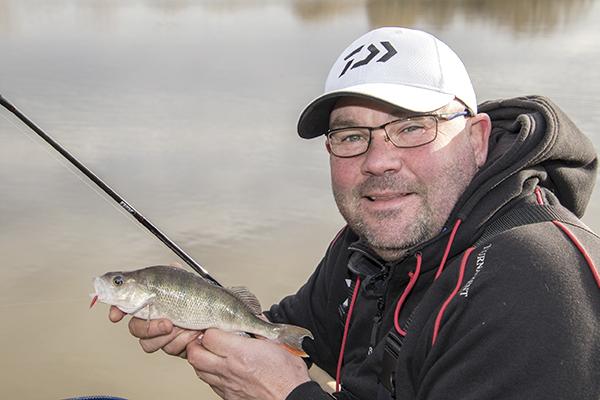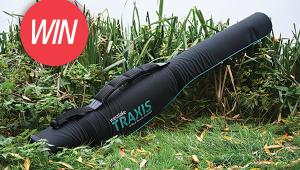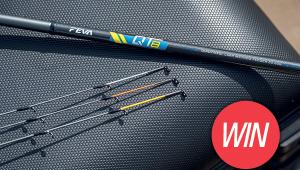Earn a Bonus

There’s been a explosion of small skimmers at top Midlands venue Barston Lake, where you need to keep the 3 and 4oz fish coming at a constant rate if you want to make a dent in the frame/section weights. They make for a busy session, but to really put a weight in your net you need to find the big skimmers and small bream, and to find out how he tackles the venue we joined England ace Will Raison for a winter session on Peg 95 – not the most noted peg on the lake for a big net of silvers.
“Considering that we are in the middle of winter, it’s still mild and there’s still plenty colour in the water,” he pointed out, as he placed the cable to his digital thermometer into the water.
“I’ve mentioned before that I use a thermometer a lot these days, as it gives me an idea as to whether the fish will feed. It may be mild, but we’ve had some serious rain recently and it’s cold water!
“That can have a knock-on effect as it cools the water, even though the breeze has been a warm southwesterly. The conditions today are bright and it’s a bit chilly, but there’s little wind on the water.
“The display reads 7.5ºC, so it’s a little colder than I would have expected, since there have been no frosts to speak of. I have to put that down to the cold rain water.”
Before setting up his rods for the session, Will mixed up a bag of Daiwa Advantage Sweet Fish Meal groundbait. He explained that the dark feed is a good option when skimmers are the target in cooler conditions, as it’s quite low in the percentage of fishmeal, compared to other feeds he’s used. It also contains grilled hemp and coriander, so it’s an active mix that will add plenty of attraction in the coloured water.
The feed was left to absorb the water while Will set up the two rods he planned to use during the session. Both were the new 10ft Daiwa N’Zon Z Method Feeder models with 0.75g tips.
“I’m fishing with 8lb Daiwa ST mono rather than braid, and the softer tip will ensure a positive bite from the small skimmers. The stronger mono is also insurance should I hook into a carp.”
The setup that Will chose to fish may be familiar to some, as it incorporated a length of 6lb power gum between the swivel and his hooklength.
“It’s the same as the rig I fish for F1s when feeder fishing on Middle Lake at Gold Valley. The running feeder rests against the buffer bead over the swivel. I then have a 20cm length of power gum attached to the other end of the swivel.
“The ‘tag end’ has a knot tied in it, so that I can attach the hook link in the same way that you fix a pole rig on a Dacron connector. I’m only fishing with a 0.12mm fluorocarbon hook link, so the power gum acts as a bungee if a big fish turns up.”
Will planned to fish both a groundbait line and a maggot feeder line, the first at 26 metres and the latter well past to try and pick up some bonus fish while the shorter line settled. The 15in hook link for the groundbait feeder line had a size 16 Gama Pellet hook to fish a single or double dead red maggot. For the maggot setup, it was 15 inches of 0.15mm fluorocarbon and a size 16 B911, which enabled Will to fish three dead red maggots. Both setups were clipped up, the groundbait rig set using distance poles to gain an accurate cast, the maggot setup at around 10 metres beyond that.
A little extra water had to be added to Will’s groundbait before he was happy that it was ready, and once that was sorted he switched his attention to the baits he would use during the session. That would be all about the grubs, as he has live red maggots, dead reds, pinkies and dead squatts. “When allowed, the matchmen here have been fishing with bloodworm and joker, but because there are so many tiny skimmers it’s been difficult to catch the better fish, as the blades hit the hook bait first.
“The dead red squatts will mimic the bloodworm and attract the smaller fish, and hopefully keep them off the bigger offerings long enough for the bigger skimmers to home in on.”
A small pinch each of the squatts and pinkies were added to the feed, and then Will sent out 11 feederfuls, using a new 30g N’Zon open-ended feeder, to his 26m mark.
“That might have looked like a lot of feed, but if you were to take the same amount and ball it, ready to put in a pole pot, it’s actually not much at all. It’s a great way to gauge what you are feeding when fishing any type of feeder.
“I have fed quite a bit as the water is coloured. If it had been clear, but the same temperature, then I would have fed two feeders-worth at most. I would also start with a longer hooklength, as the fish can be wary of the feed at first.”
Either way, Will pointed out that he would then leave the line for around 60 minutes to allow the fish to gain confidence to approach the feed before having the first look. Until then he would concentrate on the maggot feeder. Feeder choice for the maggots was a Drennan Carp feeder, as it had all the weight at its base so that it could be cast accurately over a distance. It also had large holes that allowed slow-moving maggots (they don’t move quickly once submerged in cold water) to escape more easily.
With three dead reds on the hook, the feeder was fired out and then it was all about the wait to see if a bonus skimmer would find the bait. Only four casts were made in the first hour, and with no interest Will made the switch to his groundbait setup. Swapping the 30g feeder for a 20g model, he pinched two dead reds on the hook and sent his rig over the bed of feed.
“I’m not going to time how long I leave the bait out there, as you would in the summer, as a cautious approach is better when looking for not that many bites. I will recast when I feel it’s right, probably no more than 10 minutes, as it’s important to make some noise and add a little extra attraction to the water.”
A small skimmer was the first fish of the day, on the second cast, and then it was similar size fish for the following 90 minutes. The action wasn’t frantic, but Will had started to build a weight. The first really big skimmer came after almost two hours on the groundbait line.
“That’s the result you’re looking for. These fish weren’t being caught on the bloodworm. A few of these will really boost your weight if you want good points or are looking for a section win or frame place.”
More small skimmers were netted plus a nice perch in the next 50 minutes, and then the biggest fish of the session was landed – a 1½lb skimmer. That was quickly followed by a similar size fish. After that the action slowed somewhat, and having caught just a few small skimmers, Will switched back to the maggot feeder setup, and set the distance to fish a few metres past his feed line.
“It feels as though the fish have backed off, and as there seem to be a few better fish in the area I’m going to see if I can get a few interested in a bit more food.” The change of tactic worked after a fashion, however, it was small skimmers until the end of the session.
“It’s a good double figures,” Will pointed out, as he assessed his catch. “I’m pleased that I chose this peg to try and show how to get the bonus fish, as it’s not in a brilliant area, but there were fish topping when I arrived, so there were fish to be caught.
“I realise that not everyone can afford bloodworm and joker, but adding dead squatts to the feed certainly pulled in the small skimmers, so they are a good alternative when there are loads of small fish to catch. “It’s not been the ideal conditions to catch today. Yes the water is coloured and its temperature is still good, but the lack of a breeze bright sky is not great on a shallow venue like Barston. I think that it would have been even better had there been a ripple on the surface today.”
- Log in or register to post comments













